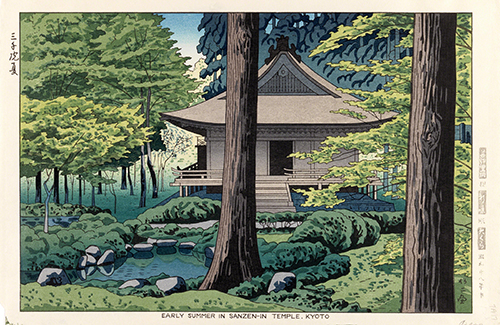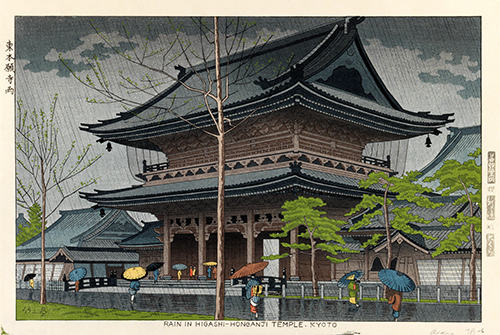Cool Off with Cool Colors: Asano Takeji
July can be moderately hot in Massachusetts, but I understand some regions of the world are having the hottest July ever recorded (probably due to climate change). So, if it’s hot by you, just stare at this beautiful woodcut print and feel the cool breezes wafting over you!
 |
| Asano Takeji (1900–1999, Japan), Early Summer in Sanzen-in Temple, Kyoto, 1931. Color woodcut print on paper, 10 7/8" x 15 ¾" (27.6 x 40 cm). © 2019 Brooklyn Museum. (BMA-2818) |
Efforts to revive the spirit of ukiyo-e-style color woodcut prints by certain Japanese artists in the early 1900s—resulting in the shin hanga (new print) and sosaku hanga (creative print) movements—produced some of the most stunning landscapes, easily rivaling those of Hiroshige and Hokusai. You’ll remember (of course you do!) from previous postings that the shin hanga artists followed the traditional hierarchy of artist, woodblock carver, and printer as separate jobs, while the sosaku hanga artists drew the composition, carved the block, and produced the print themselves.
Asano Takeji was born in Kyoto and graduated in 1919 from the Kyoto City School of Fine Arts and Crafts. He also studied traditional Japanese painting in the Kyoto City Specialist School of Painting. In 1928, he became interested in woodblock printing through a course taught by Hiratsuka Un’ichi (1895–1997), one of the founders of the sosaku hanga movement. In 1929, he helped establish the Kyoto Creative Print Society, meant to foster appreciation for the sosaku hanga genre of print. Asano worked in both the shin hanga and sosaku hanga methods. Unfortunately, he did not carve or print either of prints I’m showing you, as evidenced by the carver, printer, and publisher seals on the right margin. Despite this, he taught the sosaku hanga carving well into his 90s.
Asano and his fellow print artists were very aware of the vast market available for this art form in the West, thus the titles printed in both Japanese (upper left) and English (lower margin). This was driven home by the fact that ukiyo-e-style print artists had won prizes at the Paris Universal (Exposition) of 1900.
The enduring beauty of these prints is the painstaking effort to preserve the Japanese ukiyo-e tradition of capturing views of cherished spiritual landmarks. Although Western perspective rules these prints, the basic decorative elements of artists such as Hiroshige (1797–1858) remained: the feathery description of leafy trees, the parallel vertical lines at a slant to indicate rain, and the basic palette.
This view of Higashi-Hongan-ji Temple comes from a notable series Asano created for the publisher Unsodo called Noted Views in the Kyoto-Osaka Area. These shin hanga prints continue to be reproduced to the present day.
 |
| Asano Takeji, Rain in Higashi-Honga-jii Temple, Kyoto, 1953. Color woodcut print on paper, 10 ¾" x 15 ¾" (27.3 x 40 cm). © 2019 Brooklyn Museum. (BMA-2508) |
Correlations to Davis Programs: Experience Printmaking: 4; The Visual Experience 3E: 3.5, 13.5; Discovering Art History 4E: 2.3, 4.1


Comments